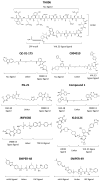Proximity-Induced Pharmacology for Amyloid-Related Diseases
- PMID: 38474412
- PMCID: PMC10930901
- DOI: 10.3390/cells13050449
Proximity-Induced Pharmacology for Amyloid-Related Diseases
Abstract
Proximity-induced pharmacology (PIP) for amyloid-related diseases is a cutting-edge approach to treating conditions such as Alzheimer's disease and other forms of dementia. By bringing small molecules close to amyloid-related proteins, these molecules can induce a plethora of effects that can break down pathogenic proteins and reduce the buildup of plaques. One of the most promising aspects of this drug discovery modality is that it can be used to target specific types of amyloid proteins, such as the beta-amyloid protein that is commonly associated with Alzheimer's disease. This level of specificity could allow for more targeted and effective treatments. With ongoing research and development, it is hoped that these treatments can be refined and optimized to provide even greater benefits to patients. As our understanding of the underlying mechanisms of these diseases continues to grow, proximity-induced pharmacology treatments may become an increasingly important tool in the fight against dementia and other related conditions.
Keywords: PROTACs; amyloid-related diseases; conformational diseases; drug discovery; neurodegenerative diseases; proximity-induced pharmacology.
Conflict of interest statement
The authors declare no conflicts of interest.
Figures
References
Publication types
MeSH terms
Substances
Grants and funding
LinkOut - more resources
Full Text Sources
Medical
Research Materials



